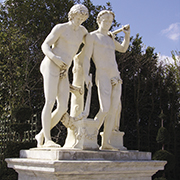Jean-Philippe Rameau’s opera Castor et Pollux was an outstanding success, though initially in the reworked version of 1754. The performance material for this work is now available. The volume from the Complete Edition will follow.
An unusual fate still affects Jean-Philippe Rameau’s third opera Castor et Pollux today. It was premiered at the Académie royale de musique in October 1737 as a Tragédie lyrique in a prologue and five acts, and was only revived seventeen years later, in January 1754. Reworking his own stage works was not unusual for Rameau, and there are numerous examples of this including Dardanus (1739, 1744), Platée (1745, 1749) and Zoroastre (1749, 1756). But the fact that a work was neglected for so long after its premiere, as with Castor et Pollux, seems odd. Rameau was undoubtely disappointed about the lukewarm reception of the premiere, and he agreed to revise the opera only under pressure from the two directors of the Académie royale de musique, François Rebel and François Francœur. Like Rameau, they regarded a revival of Castor et Pollux as a suitable means of supplying evidence of the supremacy, influence and greatness of the French style in the ‘Querelle des Bouffons’ raging against the supporters of Italian opera buffa.
For the new version Rameau cut the prologue and had Pierre-Joseph Gentil-Bernard rewrite the libretto. Rameau wrote a new first act and amalgamated the original five acts into four, in the process reworking the slightly modified acts III and IV of 1737 into a new fourth act. Acts I, II and V of 1737, which also had some alterations, became acts II, III and V in the new version. The original love story of the sisters Télaïre and Phoebé and the brothers Castor and Pollux was simplified, in the process of which greater importance was given to the two brothers’ friendship. Right at the beginning of the first act Pollux forgoes his love for Télaïre in favour of his brother Castor; at the end of this act, Castor is killed by Lincée at the instigation of the jealous Phoebé. After resisting the delights of the “pleasures” and defeating the monster of the underworld, Pollux sacrifices his immortality by declaring that he is willing to take his brother’s place in the underworld so that Castor can win back his Télaïre. This sacrifice does not leave Jupiter unmoved. He grants Castor and Télaïre immortality and gives them a place as a constellation next to Pollux.
In contrast with its premiere in 1737, Castor et Pollux enjoyed a glittering success in January 1754, and after that the work was performed regularly until May 1755. A performance took place at the royal court in November 1763, and in January 1764, six months before the composer’s death, a series of performances began at the Académie royale de musique which lasted until June 1765. The work was also regularly performed from 1770 till 1782 – unmistakable evidence of its popularity.
Thanks to a recently-discovered manuscript which matches the autograph revised by Rameau in the last months of 1753 in many respects, this second version, with its tauter plot, reverts to a glittering, refined orchestration. The new critical edition has an Appendix containing the additions and alterations which Rameau undertook in his characteristic drive for perfection for the revival of the opera in 1763/1764. And so this version, which is now unjustly in the shadow of the 1737 version, is revealed in its full dramatic power and greatness.
Denis Herlin
(translation: Elizabeth Robinson)
(from [t]akte 1/2014)



